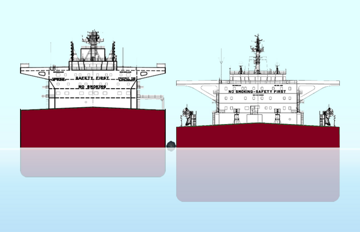Ship to Ship Transfer Operations are described with the standards of MARPOL Annex I, Chapter 8, as amended by Resolution MEPC.186(59): Prevention of Pollution during Transfer of Oil Cargo between Oil Tankers at Sea, Regulations 40, 41, 42.
The regulations apply to oil tankers of 150 gross tonnage and above engaged in the transfer of oil cargo between oil tankers at sea (STS operations) and their STS operations. The regulations shall not apply to bunkering operations.
Ship-to-ship transfer operations, also known as lightering operations, are operations where crude oil or petroleum products are transferred between seagoing tank ships moored alongside each other at sea. Such operations can take place when one ship is at anchor or both are underway at very low speed. In general, the operation includes the approach maneuver, berthing, mooring, hose connecting, transfer of cargo, hose disconnecting, unmooring, unberthing and departure maneuver.
The STS transfer operations include:
-
The conventional or standard lightering process, where the discharging vessel is fully loaded, while the receiving vessel is in ballast condition. (see Figure 1);
-
The reverse lightering process, sometimes referred to as “topping-off”, where the laden supply tanker discharges to a partially laden receiving tanker.
(see Figure 2).
In general, the STS transfer operation process can be divided into 5 phases as outlined in the following table:
-
Phase 1. Pre-Arrival Planning: The Pre-Arrival Planning should be carried out before any STS operations commence. The planning of the STS operation could be performed by the ships operators and managers together.
-
Phase 2. Arrival: During the Arrival stage of the operation the two ships conducting the STS operation should establish radio communication, and concur that all operational procedures has been assessed and agreed upon.
-
Phase 3. Berthing: The Berthing phase of the STS operation consists of the maneuvering and mooring of the two ships. For the maneuvering operation a contingency plan should be in place to deal with any emergency situation.
-
Phase 4. Cargo Transfer: The Cargo transfer phase should only commence once the two ships are securely moored. The Master should ensure that all the recommended safety procedures in this plan are followed. A contingency plan should be in place to deal with any emergency situations during cargo transfer
-
Phase 5. Departure: Departure is the last phase of the STS operation.
IBICON offers services to your company for the development of "Ship to Ship Transfer Operations Plan", taking into account the recommendations of organizations of the maritime industry, including IMO, OCIMF, ISF and leading classification societies (DNV, BV, ABS, LR, GL, RS). IBICON has developed the STS operations Plan, which meets the requirements of Resolution MEPC.186 (59).




